Sudoku Variants
Little Killer Sudoku
Jun 21st
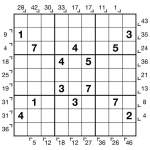
Little-Killer Sudoku 9×9 1 puzzleIn Little-Killer Sudoku the total of each of the diagonals in the grid, other than those 9 cells long, is given. Each number has an arrow next to it which points to the diagonal it gives the sum of, so therefore the top-left cell in this grid must be a 9 thanks to the arrow immediately below and to the left of it. Unlike in regular Killer Sudoku, there is no restriction on repeating digits in any sum.
I’ve also seen Little Killer puzzles which have an additional restriction that no number can repeat on either of the two main diagonals, but I haven’t used that rule here, so numbers can repeat. Apart from the addition of the Little Killer clues, this is a regular Sudoku puzzle.
Diagonal Non-Consecutive Sudoku
Jun 19th
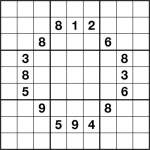
Sudoku Non-consecutive-diagonal 9×9 1 puzzleThis is a non-consecutive-diagonal sudoku puzzle. No digit may be diagonally-adjacent to a consecutive digit. But as you can see from the givens, consecutive numbers can be adjacent horizontally or vertically. What you can’t have, for example, is a 1 diagonally next to a 2 because the 1 & 2 are ‘consecutive’ (have a numeric difference of 1).
Consecutive Snake Sudoku
Jun 15th
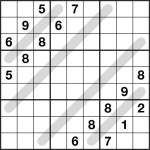
Sudoku Snake 9×9 1 puzzleHere’s something a little different – a consecutive snake sudoku.
Each of the shaded snakes consists of only ‘consecutive’ cells along its length, which means that any two cells joined by a snake must have values with a difference of 1, such as 2&3 or 7&8. So for example the 4-square-long snake at the top-left might have 2323 along its length, or any valid fit such as that.
In addition follow usual sudoku rules. Also note that only the cells joined by the snakes have any special relationship – any other pair of cells may or may not be consecutive (unlike in regular consecutive sudoku).
Trio Odd-Even Sudoku
Jun 14th
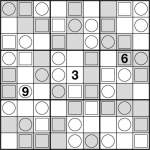
Sudoku Trio Odd/Even 9×9 1 puzzleI often post pretty challenging puzzles here, so I thought I’d entirely reverse that trend by publishing probably the easiest 9×9 puzzle with minimal givens you’ve ever seen.
Simply place 1-9 once each into every row, column and bold-lined region, as in a regular sudoku, but in this Odd/Even puzzle all of the even digits are in shaded cells. This is also a Trio sudoku too so each of the cells with an inset square contains 4, 5 or 6 and each of the cells with an inset circle contains 7, 8 or 9. Those without an inset square or circle contain 1, 2 or 3.
Using these rules you need only 3 givens for a valid unique puzzle. ![]() That’s the minimum number as you can probably easily convince yourself, because, despite its perhaps intimidating appearance, it’s essentially a set of trivial 1- and 2-digit sudokus laid on top of each other.
That’s the minimum number as you can probably easily convince yourself, because, despite its perhaps intimidating appearance, it’s essentially a set of trivial 1- and 2-digit sudokus laid on top of each other.
Jigsaw Blackout Sudoku
Jun 13th
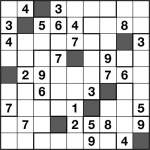
Blackout Jigsaw Sudoku 9×9 puzzleIf you like tricky Sudoku variants, here’s one just for you! It’s a Blackout Sudoku with Jigsaw regions.
The rules are simple: in each row, column and bold-lined jigsaw region you must place 8 different digits in the range 1 to 9. Don’t place a digit on the shaded squares.
If you prefer you can consider it as a standard jigsaw sudoku where the black cell can represent any value, and the value can be different for the row, the column and the jigsaw region. For example the shaded square on the top row could take the place of a 7 in that row, an 8 in its column and a 2 in that jigsaw region.
Good luck! ![]()
King of Argyle Sudoku
Jun 8th
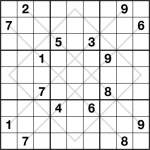
Sudoku Anti-King Argyle 9×9 1 puzzleSometimes it’s fun to mix variations together, so here’s a combination of Anti-king and Argyle Sudoku.
Anti-king means that no number repeats a “king’s move away in chess”. In practice this means that no two identical numbers touch in any direction, including diagonally.
Argyle means that no number repeats on any marked diagonal. The diagonals form an ‘Argyle’ Scots tartan pattern.
And since it’s a Sudoku, you must also place 1 to 9 in each row, column and bold-lined 3×3 box.
Good luck!
Argyle Sudoku
Jun 1st
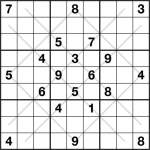
Sudoku Diagonal 9×9 1 puzzleI’m working on lots of different Sudoku variants for my forthcoming book, so I thought I’d post some of them here. On that basis, here’s an Argyle Sudoku puzzle. Just follow the usual rules but also note that you can’t repeat a digit in any of the marked diagonals.
You can now also keep track of this and future puzzles I publish using The Griddle’s puzzle tracking system. The following buttons update the status of the puzzle:
Sudoku [Jigsaw] 6×6
Dec 7th
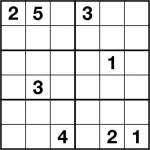
Sudoku 6×6 puzzle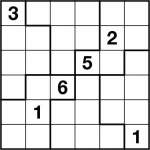
Jigsaw 6×6 puzzle
I had a couple of 6×6 Sudoku puzzles left over when making issue 58 of Sudoku Pro magazine, so I thought I’d post them here.
Just place 1-6 into each row, column and bold-lined area.
Samurai Killer Sudoku Pro 6×6
Apr 27th
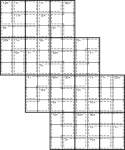
Killer Sudoku Pro 6×6 Samurai puzzle
It’s been quiet here recently – much of my effort has been going on my UK General Election site, How To Vote, although Sudoku Xtra 6 was out on Saturday too. Anyway, there are still 10 days to go to the election but after that I’ll get some time back!
However I thought I should finally post another puzzle – so here one is. Place 1 to 6 in each row, column and 2×3 box (rows and columns are defined by the three underlying 6×6 grids, which you have to infer from the stepping). Also place numbers so that the value at the top-left of each dashed-line cage results from applying the operation between all the value in that cage. For subtraction and division start with the largest value.
Have fun! ![]()
Toroidal Killer Toroidal Jigsaw Sudoku
Mar 19th
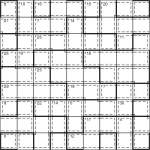
Toroidal Killer Jigsaw Toroidal puzzle
A while back someone asked for some variant toroidal patterns on PuzzleMix, so I was just adding a couple of them to the daily puzzles section when it occurred to me that I could put up a few toroidal killer sudoku too, for a change. However I then realised that the code which creates the HTML will need editing to cope with toroidal regions, but I knew my PDF code was more flexible… and then I thought it would be great to mix this with some toroidal jigsaw regions too… and here’s the somewhat confusing result! A Toroidal Killer with Toroidal Jigsaw regions.
Now if you enjoy this twisted beast let me know, otherwise I probably won’t make any more of them! ![]()
Full rules:
- Place 1 to 9 in each row, column and bold-lined jigsaw region
- Place numbers so that the dashed-line cages add to the total given
- No number can repeat in a dashed-line cage.
- Some jigsaw regions and cages ‘wrap around’ the outside the puzzle, continuing at the start/end of the same row/column
Good luck! ![]()

Recent Comments